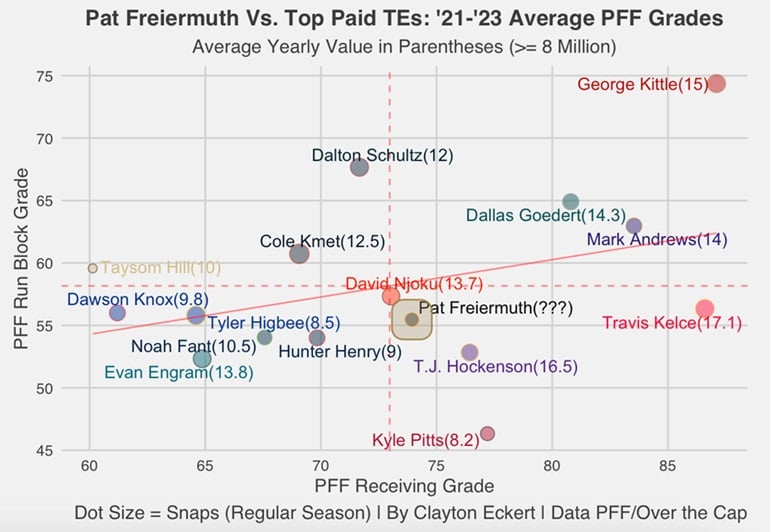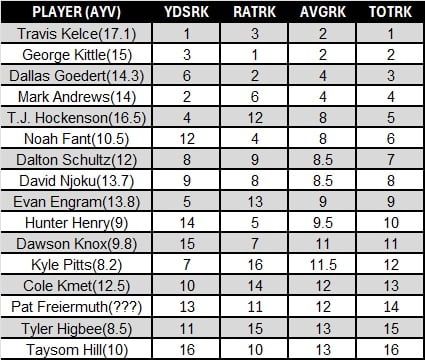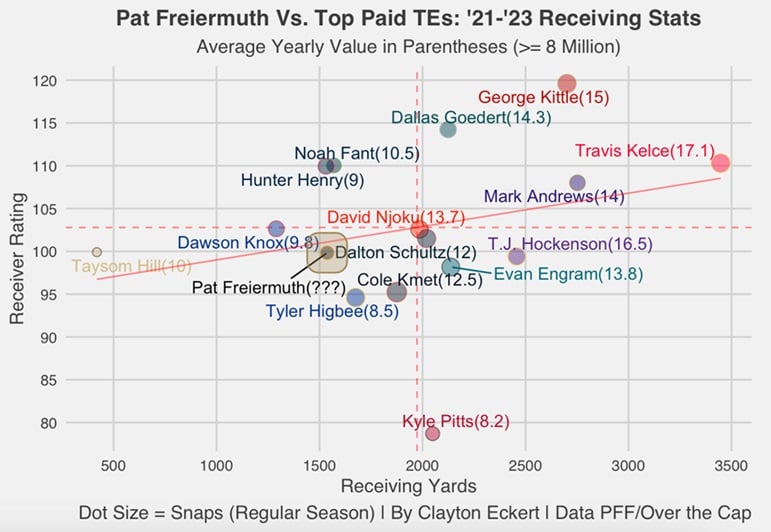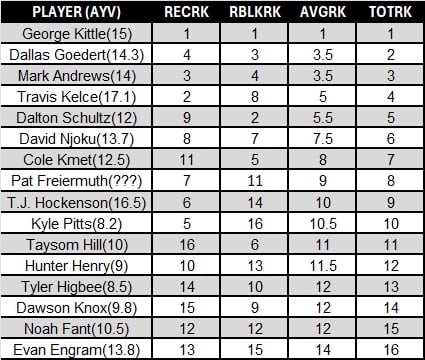A candidate for a contract extension with the Pittsburgh Steelers is tight end Pat Freiermuth. My goal today is to use a statistical approach to see how Freiermuth has performed the last three seasons compared to the top-paid players at the position currently via Over The Cap.
First, I wanted to see where Freiermuth stacked up among TEs at an average yearly value of 8 million or more in grades from Pro Football Focus (PFF), viewing their average receiving and run block grades the last three years, along with total snaps over the span as their dot sizes:
Here, we see several familiar names in general among the top-paid TEs along with the top grades as well. Out of the 16 qualifiers, only three landed above the mean in both data points: 49ers George Kittle, Ravens Mark Andrews, and Eagles Dallas Goedert. Each have an average yearly value of at least 14 million.
Freiermuth was slightly above the mean as a receiver, with a 73.9 grade that ranked seventh over the three-year span. That was expectedly the better mark going into the study, compared to a below average 55.5 run block grade that landed 11th.
Seeing some of the company he’s with on the bottom right of the visual, aka stronger receivers than blockers, also can get you paid handsomely: Travis Kelce ($17.1 million), T.J. Hockenson ($16.5 million). Overall, while run blocking is important, the visual emphasizes that the most lucrative contracts as we sit here today were exercised to stronger receivers. That comes as no surprise.
Now we have a sense of the ceiling of contracts at the position currently, and what Freiermuth’s second contract could potentially slot in to be.
For more context, here are Freiermuth’s grades and ranks by season among the 16 qualifiers:
2021: 74.8 receiving grade (eighth), 53.2 run block grade (13th)
2022: 78.3 receiving grade (sixth), 59.6 run block grade (eighth)
2023: 68.7 receiving grade (12th), 53.6 run block grade (13th)
2022 were Freiermuth’s best marks in both data points with a positive trend in each category. Discouragingly, 2023 were his worst combined ranks in an injury-shortened year, contributing to the second-least total snaps in the timeframe. Poor quarterback play, particularly last season had a lot to do with this as well, but that factor isn’t limited to Freiermuth either.
After his first two years, Freiermuth joined rare company as one of only two TEs with 60-plus catches in each season. Ideally, he will return to that level with Pittsburgh’s revamped quarterback room and new offensive coordinator that utilizes TE frequently, along with a larger second receiver role behind George Pickens seemingly his for the taking.
If all those stars align, getting an extension done this summer could be cleaner and get ahead of a hopeful huge 2024 for Freiermuth.
Going deeper, here is a ranking table of the grades from the first visual, including receiving grades (RECRK), run block grades (RBLKRK), averaging the two (AVGRK), then using total snaps as a tiebreaker to get a final ranking (TOTRK) of the 16 qualifying players along with their average yearly values (AYV) in parenthesis:
Freiermuth lands at the eighth-best total rank, slotting between Chicago’s Cole Kmet ($12.5 million) and Hockenson ($16.5 million). The latter was an extreme contract ceiling for Freiermuth laid out by our cap guru Dave Bryan last summer, but needed a stronger 2023 for that aspiration, emphasizing a number closer to Kmet’s being more likely.
En route to that total rank was the aforementioned seventh-ranked receiving grade for Freiermuth, along with landing 11th in run block grade. Considering Freiermuth and the Falcons Kyle Pitts are the only players in the top ten still on their rookie contracts, a number between 12-14 seems fair from a statistical perspective.
Next, I wanted to look at total yards and average receiver ratings over the three-year span:
This view is less favorable for Freiermuth, landing below the mean in both data points. His 1,537 receiving yards the last three seasons ranked 13th (fourth-least) along with a 99.8 receiver rating that landed at 11th.
Discouraging on the surface, but aforementioned poor QB play and a Pittsburgh offense that lacked a middle of the field attack and scoring with former OC Matt Canada are hopefully pasts issues that will lend for optimistically stronger results to come.
Here’s the year-to-year breakdown of the stats:
2021: 497 receiving yards (13th), 123.9 receiver rating (third)
2022: 732 receiving yards (sixth), 78.1 receiver rating (15th)
2023: 308 receiving yards (14th), 97.5 receiver rating (tenth)
The receiver ratings echo my recent point of the issues the last two seasons, towards the bottom of the results particularly in 2022. Freiermuth’s rookie year was rather encouraging though, with a strong third ranking.
With the new pieces at QB and OC, who each have better recent scoring resumes lead to optimism for 2024. Particularly in the red zone, where Pittsburgh has to be better, and seemingly have the pieces to do so including Freiermuth.
2022 was best in terms of receiving yards, ranking sixth that season. Otherwise though, we see low totals in comparison, landing in the bottom-four ranks in 2021 and 2023. The second-year leap was evident encouragingly, but playing in just 12 games in 2023 obviously capped Freiermuth’s 2023 campaign where many (himself included) expected more.
Here are his snap totals by season for context:
2021: 684
2022: 743
2023: 474
Last season, Freiermuth’s playing time was the least of his three-year career to date by far, limited to just 12 games and 474 snaps. Injuries are part of the game, and impacted others at the position last season as well, as Mark Andrews felt last year.
As I alluded to earlier, hoping Pittsburgh bets on luck in these terms despite recent injury, possibly getting a bang for their buck that hopefully pays dividends through the span of a potential extension.
Now, here is a similar ranking table as earlier, including receiving yards (YDSRK), receiver rating (RATRK), averaging the two (AVRRK), then using the same tiebreaker of total snaps to get the final rank (TOTRK):
Much less favorable here, with Freiermuth landing 14th in total rank out of the 16 qualifiers. His yards rank was the biggest culprit, landing 13th in that regard while his rating rank landed 11th. There are several factors I mentioned throughout the article that contributed to this, including many that were out of his control.
When considering a possible contract extension, the data left more to be desired overall. While that is true, Freiermuth could be one of the biggest benefactors to the wholesale changes for the 2024 Pittsburgh offense.
I personally think if a new deal gets done, an AYV around 12-14 million would be fair given the circumstances, and here’s to hoping the Steelers ink him as an integral piece that pays off moving forward.





